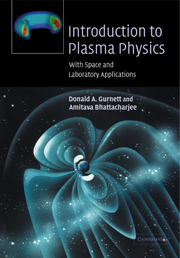Book contents
- Frontmatter
- Contents
- Preface
- 1 Introduction
- 2 Characteristic parameters of a plasma
- 3 Single particle motions
- 4 Waves in a cold plasma
- 5 Kinetic theory and the moment equations
- 6 Magnetohydrodynamics
- 7 Discontinuities and shock waves
- 8 Electrostatic waves in a hot unmagnetized plasma
- 9 Waves in a hot magnetized plasma
- 10 Non-linear effects
- 11 Collisional processes
- Appendix A Symbols
- Appendix B Vector differential operators
- Appendix C Vector calculus identities
- Index
- References
6 - Magnetohydrodynamics
Published online by Cambridge University Press: 05 June 2012
- Frontmatter
- Contents
- Preface
- 1 Introduction
- 2 Characteristic parameters of a plasma
- 3 Single particle motions
- 4 Waves in a cold plasma
- 5 Kinetic theory and the moment equations
- 6 Magnetohydrodynamics
- 7 Discontinuities and shock waves
- 8 Electrostatic waves in a hot unmagnetized plasma
- 9 Waves in a hot magnetized plasma
- 10 Non-linear effects
- 11 Collisional processes
- Appendix A Symbols
- Appendix B Vector differential operators
- Appendix C Vector calculus identities
- Index
- References
Summary
Historically magnetohydrodynamics, abbreviated MHD, preceded the development of modern plasma physics. The original intent of MHD was to treat a plasma as a conducting fluid [see Cowling, 1957]. The governing equations were adapted from fluid mechanics with appropriate modifications to account for electrical forces. To obtain a complete set of equations, it was necessary to specify the current as a function of the applied electric field. This was accomplished by using a linear Ohm's law, such as is often used to describe conducting media. Since, to a first approximation, plasmas are electrically neutral, the net charge density was assumed to be identically zero. Also, since fluid motions tend to be slow compared to the characteristic time scales of a plasma, the displacement current was assumed to be small compared to the conduction current. These assumptions, together with an appropriate equation of state, were sufficient to obtain a closed system of equations.
Although it would be adequate simply to write down the equations of MHD as they were originally postulated, it is useful to try to derive the equations from first principles, using the moment equations developed in Chapter 5. Although this procedure will only be partially successful, it has the advantage of revealing more clearly the underlying assumptions and the range of applicability of MHD. It also has the advantage of providing a theoretical basis for precisely defining certain quantities, such as the fluid velocity and the plasma pressure.
- Type
- Chapter
- Information
- Introduction to Plasma PhysicsWith Space and Laboratory Applications, pp. 175 - 250Publisher: Cambridge University PressPrint publication year: 2005



